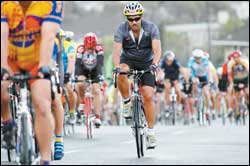Energy sums shows bicycles are the way to go
23 March 2006
Ever wondered how much energy the
A reasonably fit cyclist can continuously generate about 100W of power, enough to light a standard light bulb, says Professor Trevor Gaunt of the Department of Electrical Engineering.
Using an average tour time of four hours (ignoring resting on the downhills!), the average cyclist produced 400Wh of energy. Thus,
Maybe this energy can be put to good use to address the current energy crisis in the Western Cape? The City of Cape Town has an electricity demand of
In transport terms, the tour moved 3,8-million passenger-km.
Considering "conventional" transport options, if each of the cyclists decided to drive the same 109km route in
Which shows:
- bicycles provide remarkably effective transport
- cities need huge amounts of energy
- cyclists are not a significant source of sustainable energy.
 This work is licensed under a Creative Commons Attribution-NoDerivatives 4.0 International License.
This work is licensed under a Creative Commons Attribution-NoDerivatives 4.0 International License.
Please view the republishing articles page for more information.










